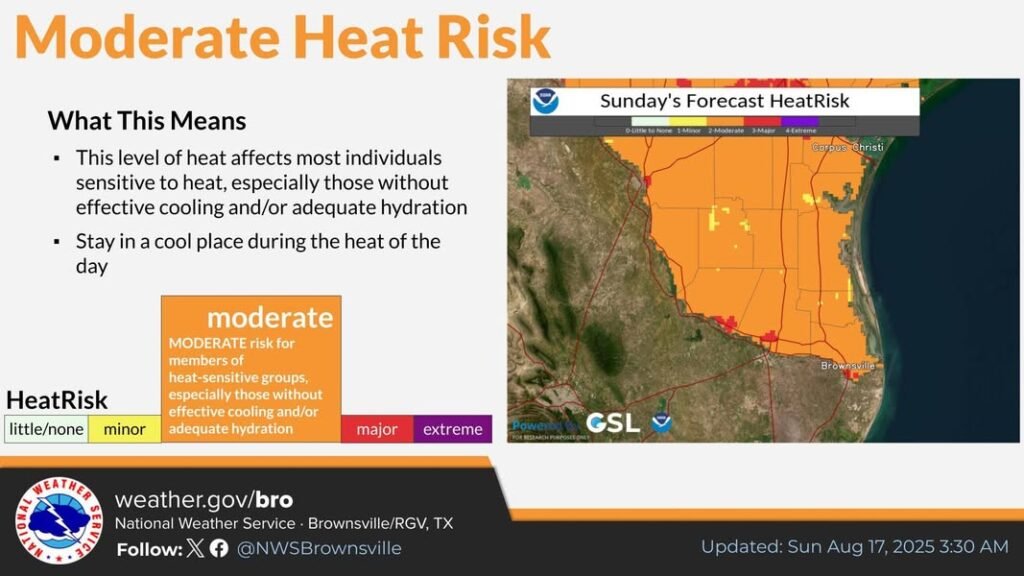Preparing for Extreme Heat: Staying Safe Amid Rising Temperatures
As summer unfolds, many citizens are bracing for an intense wave of heat this afternoon. According to the National Weather Service, the heat index in our area is expected to soar, potentially reaching temperatures as high as 110 degrees Fahrenheit. This warning serves as a crucial reminder that precautions are necessary when facing extreme weather conditions.
Understanding the Heat Index
The heat index is a critical measure that combines air temperature and humidity to determine how hot it feels to the human body. When the heat index climbs, it can lead to serious health risks, including heat exhaustion and heat stroke. This afternoon’s projected heat index values indicate that individuals—especially vulnerable populations—must take proactive measures for safety.
Why Hydration is Key
One of the essential tips for staying safe in extreme heat is to stay hydrated. Dehydration can occur quickly when temperatures rise, impairing the body’s ability to cool down. Here are a few hydration tips:
- Drink Water Regularly: Aim to consume water frequently, even if you don’t feel thirsty. It’s recommended to drink at least 8-10 cups of water a day, but this amount may increase with high temperatures.
- Avoid Alcohol and Caffeine: Beverages like coffee and alcohol can contribute to dehydration. Opt for non-caffeinated drinks.
- Eat Hydrating Foods: Incorporate fruits and vegetables with high water content, such as cucumbers, melons, and oranges, into your meals.
Recognizing Heat-Related Illnesses
Understanding the signs of heat-related illnesses is crucial for preventing severe health outcomes. Common symptoms include:
- Heat Exhaustion: Symptoms can include heavy sweating, weakness, dizziness, nausea, and headache.
- Heat Stroke: This is a medical emergency. Symptoms involve high body temperature (104°F or greater), altered mental state, and absence of sweating. If you suspect someone is exhibiting symptoms of heat stroke, seek medical help immediately.
Essential Tips for Outdoor Activities
If you have plans to spend time outdoors, take precautions to stay safe while enjoying the summer weather. Here are some effective strategies:
- Limit Outdoor Activities: Try to schedule activities in the early morning or late evening when temperatures are cooler.
- Wear Appropriate Clothing: Light-colored, loose-fitting clothing helps regulate your body temperature better than dark, heavy fabrics.
- Seek Shade: Whenever possible, find shaded areas to avoid direct sunlight.
- Use Sunscreen: Protect your skin from the sun’s harmful rays with a high SPF sunscreen. Reapply every two hours, or more often if swimming or sweating.
When to Stay Indoors
The best way to combat extreme weather conditions is to stay indoors during the hottest part of the day. If you need to be outside, keep an eye on the local weather updates for guidance. Investing in an air-conditioning unit or spending time in air-conditioned public spaces, like libraries or shopping centers, can provide relief from the heat.
Resources for Further Information
For more insights on heat safety, visit resources such as the CDC which offers tips and guidelines for staying safe in extreme temperatures. For real-time weather updates, consult local weather stations or websites.
Conclusion
With today’s heat index values soaring to potentially hazardous levels, it is crucial to prioritize safety, hydration, and awareness. By understanding the risks associated with extreme heat and taking preventive measures, individuals can protect themselves and enjoy the warm weather responsibly.
Stay safe and informed—your health depends on it!


